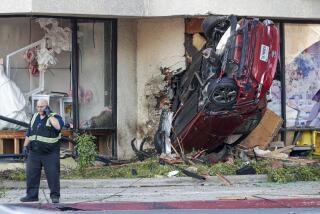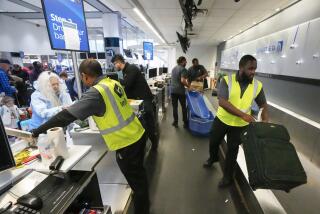U.S. to Require Safer Air Bags for Children
WASHINGTON — The federal government, in a dramatic shift in priorities, is expected to announce requirements today for a new generation of air bags that is less likely to harm small children.
The new requirements--among other changes drawn up by regulators at the National Highway Traffic Safety Administration--will require that an unbelted male adult of average size be protected in a test crash at 25 mph instead of the old standard of 30 mph.
In that small 5 mph change is a major turnaround--and a lot of history.
Air bags, first widely available in the early 1990s, are estimated to have saved more than 5,400 lives. But in one of the most painful and embarrassing object lessons on the limits of technology, they have also killed at least 158 people, 92 of them children, because the bags deploy with such force.
Like older models, the advanced air bags--which will start appearing in new vehicles within three years--inflate in a quick burst. But the new air bags will also be required to either shut themselves off or deploy harmlessly if sensors detect an infant or small child in the front passenger seat.
Originally, the government required air bags to be tested in a 30 mph frontal crash with an unbelted dummy representing a 5-foot-8, 172-pound average man.
The auto industry has blamed that requirement for the development of air bags that deployed with such power that they killed and injured children and small adults. Safety groups have countered that better engineering by automobile makers could have prevented the deaths.
“You don’t want to hurt people who are belted for the sake of protecting someone who is unbelted--that’s the social message,” said Barry Sweedler, director of safety recommendations for the National Transportation Safety Board, a watchdog agency that is among those recommending the lower-speed test. “The main thing is that we need to get more people wearing seat belts.”
Donald Huelke, a nationally known auto safety researcher who investigated more than 900 crashes in which air bags deployed, agreed with Sweedler’s assessment.
“We can’t protect everyone from everything,” Huelke said. “In the days of the polio vaccine, you had to go to the doctor and get the shot. Now, people are going to have to wear their seat belts and, if they do not wear their belts, they are not going to have optimal protection in a crash.”
Even with the new safeguards, the government will continue to recommend that children 12 and under ride in back seats.
“These changes will help to mitigate the air bag hazard but you cannot reduce the risk to zero,” said Rob Strassburger, vice president for safety at the Alliance of Automobile Manufacturers. Most of the young victims suffered broken necks and devastating head injuries.
Some safety groups criticized the government’s decision to step back from the 30 mph test, calling it a political-season sop to the powerful auto industry.
“This is a White House decision that is going to give us yesterday’s air bags rather than advanced air bags,” said Joan Claybrook, head of Public Citizen. As highway transportation safety administrator during Jimmy Carter’s presidency, Claybrook was one of the earliest advocates of air bags. She argues that air bags can be designed to protect unbelted men in high-speed crashes without harming children.
“There is no lack of technological know-how. There is just a lack of will in the auto industry to produce better air bags,” Claybrook said.
As debate has unfolded over the proper balance in air bag safety, that position lost ground. The government temporarily permitted auto makers to use lower-powered air bags beginning with 1998 models. While most cars sold since then are equipped with these lower-powered bags, which deploy with about one-third less force than earlier bags, they do not include sensors to detect small children.
Some manufacturers, including Ford, DaimlerChrysler and Porsche, have introduced vehicles with “smart” air bags that include sensors or other elements of the new system.
When regulators at the highway safety agency began drafting requirements for advanced air bags, they contemplated a gradual return to the 30 mph test. But the industry immediately protested that it would mean a reintroduction of the powerful air bags that had harmed children. A fierce lobbying campaign ensued, with volleys of letters directed at the White House from all sides.
Proponents of the 30 mph test were undercut by NTSB Chairman Jim Hall. In a March 16 letter to the White House, Clark said he was not aware of any scientific data to support a return to 30 mph tests.
Indeed, Hall said, there is no evidence that belted or unbelted adult men have suffered harm as a result of the lower-powered air bags.
“There can be no more mistakes with air bag technology,” Hall wrote. “The federal government must be certain that any newly designed air bags are safe for all occupants.”
According to people familiar with the internal debate, Hall’s strong stance--not the industry’s position--swayed the White House. “The first principle was ‘do no harm,’ ” said one source. “It went back to the issue of whether children or small adults should be jeopardized.”
A White House official said politics did not enter into the decision, adding that Vice President Al Gore’s office played no role in the debate.
Under the Transportation Department’s final decision, a return to the 30 mph test can be considered only if crash data reveal unforeseen flaws in the new air bags.
In another break with the past, the new requirements also call for air bag testing with a range of dummies, representing infants, toddlers, elementary school children and small women, as well as men.
The child dummies will be used in stationary tests to validate that air bag systems can detect the presence of children and turn themselves off. Dummies representing small women and average-size men will be used for high-speed crash tests. Previously, only male dummies have been used.
“We have learned that we cannot put blinders on and think that crash tests are the real world,” said Brian O’Neill, president of the Insurance Institute for Highway Safety. “The side effects we saw were tragic and ultimately unacceptable.”
Last year, the government estimated that advanced air bags would cost the auto industry about $2 billion a year, up to $127 per car. Those costs are likely to be passed on to consumers. But according to the government, consumers will save on repair costs in the long run because the new air bags will be less likely to deploy when they are not needed.
Manufacturers would be free to use different types of sensors with the new bags, but it is expected that some would be keyed to the weight of the person in the passenger seat.
Strassburger, the industry representative, said that he expects air bags to be a work in progress for many years. Manufacturers are now introducing side-impact air bags in front seats and there are also plans for rear-seat air bags. As part of the new requirements, the industry has agreed to closely monitor the performance of advanced air bags.






